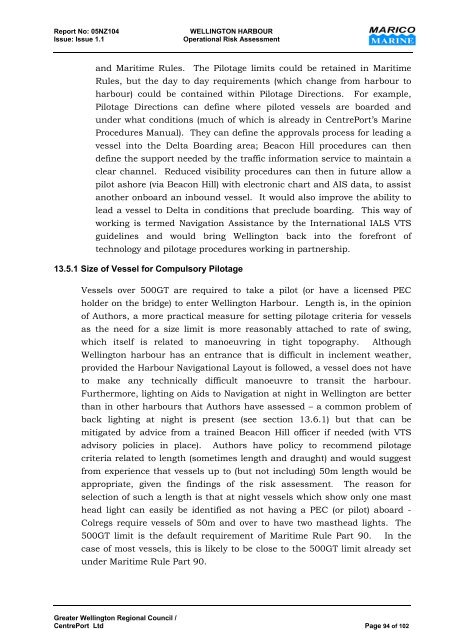MARICO Marine NZ Limited WELLINGTON HARBOUR PORT AND ...
MARICO Marine NZ Limited WELLINGTON HARBOUR PORT AND ...
MARICO Marine NZ Limited WELLINGTON HARBOUR PORT AND ...
Create successful ePaper yourself
Turn your PDF publications into a flip-book with our unique Google optimized e-Paper software.
Report No: 05<strong>NZ</strong>104 <strong>WELLINGTON</strong> <strong>HARBOUR</strong><br />
Issue: Issue 1.1 Operational Risk Assessment<br />
and Maritime Rules. The Pilotage limits could be retained in Maritime<br />
Rules, but the day to day requirements (which change from harbour to<br />
harbour) could be contained within Pilotage Directions. For example,<br />
Pilotage Directions can define where piloted vessels are boarded and<br />
under what conditions (much of which is already in CentrePort’s <strong>Marine</strong><br />
Procedures Manual). They can define the approvals process for leading a<br />
vessel into the Delta Boarding area; Beacon Hill procedures can then<br />
define the support needed by the traffic information service to maintain a<br />
clear channel. Reduced visibility procedures can then in future allow a<br />
pilot ashore (via Beacon Hill) with electronic chart and AIS data, to assist<br />
another onboard an inbound vessel. It would also improve the ability to<br />
lead a vessel to Delta in conditions that preclude boarding. This way of<br />
working is termed Navigation Assistance by the International IALS VTS<br />
guidelines and would bring Wellington back into the forefront of<br />
technology and pilotage procedures working in partnership.<br />
13.5.1 Size of Vessel for Compulsory Pilotage<br />
Vessels over 500GT are required to take a pilot (or have a licensed PEC<br />
holder on the bridge) to enter Wellington Harbour. Length is, in the opinion<br />
of Authors, a more practical measure for setting pilotage criteria for vessels<br />
as the need for a size limit is more reasonably attached to rate of swing,<br />
which itself is related to manoeuvring in tight topography. Although<br />
Wellington harbour has an entrance that is difficult in inclement weather,<br />
provided the Harbour Navigational Layout is followed, a vessel does not have<br />
to make any technically difficult manoeuvre to transit the harbour.<br />
Furthermore, lighting on Aids to Navigation at night in Wellington are better<br />
than in other harbours that Authors have assessed – a common problem of<br />
back lighting at night is present (see section 13.6.1) but that can be<br />
mitigated by advice from a trained Beacon Hill officer if needed (with VTS<br />
advisory policies in place). Authors have policy to recommend pilotage<br />
criteria related to length (sometimes length and draught) and would suggest<br />
from experience that vessels up to (but not including) 50m length would be<br />
appropriate, given the findings of the risk assessment. The reason for<br />
selection of such a length is that at night vessels which show only one mast<br />
head light can easily be identified as not having a PEC (or pilot) aboard -<br />
Colregs require vessels of 50m and over to have two masthead lights. The<br />
500GT limit is the default requirement of Maritime Rule Part 90. In the<br />
case of most vessels, this is likely to be close to the 500GT limit already set<br />
under Maritime Rule Part 90.<br />
Greater Wellington Regional Council /<br />
CentrePort Ltd Page 94 of 102
















